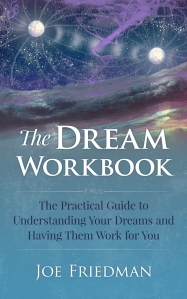Today I’m pleased to announce the publication of my new ebook, The Dream Workbook. And in line with hallowed blogger tradition, for one week only, I’m offering it at a special price to my readers.
To backtrack a bit, in 2007, Caroll and Brown published my first book, The Dream Workbook. It’s been out of print for some time, and last year, the rights reverted back to me. I decided to take the opportunity to revisit the text. I was pleased with the way it had stood up, but there were some areas where, free from a commercially minded editor, I was able to express myself more clearly.
I’ve been rewriting The Dream Workbook for some time, and it’s now in a form I’m pleased with. It’s meant as a handbook for those who want work with their dreams. For novices, it starts with sections on learning how to remember and record dreams. For those with more experience, it includes sections on having dreams to solve problems and creative impasses, techniques for understanding your dreams, and a section on what the major dream theorists — Freud, Jung, Hillman and Boss — can contribute to your understanding of your own dreams. There are lots of practical exercises and vivid examples of dream work and the way it can enrich your life.
There’s also an account of a unique dream dialogue. As far as I’m aware, it’s the first account of two dreamers influencing one another’s dreams while dreaming, and also being “aware” of the effect they’re having.
That’s the “pitch.”
And without further ado: The Dream Workbook, the Ebook.

I hope you like the cover. (The artwork is by MeKenzie Martin.)
It’s now on pre-order at Amazon, and for one week only, I’ve reduced the price for all my loyal blog readers (and their friends, relatives, early Christmas present buyers, etc. etc.). If you order now, you’ll receive it on the first day of publication, which is the 27th. Here is the link to UK Amazon, but the Amazon branch of whatever country you’re in should have it.
There will be editions on Itunes, Barnes and Noble, etc, but I think they’re a bit slow getting up. I’m also working on a Print on Demand edition (for those who want a paper copy), which should be available from Amazon in a couple of weeks.
Obviously, I’d love it if you bought it and reviewed it positively. (And if, at this ridiculously attractive price, you gave it to everyone you know…)
As a taster, here’s the start of the book:
Introduction
This aim of this book is to show you through experience just how creative, wise, useful and entertaining dreams are. It’s full of practical exercises to help you understand and use your dreams to solve problems and gain insight. You will learn to value your dreams – not because Freud or someone else has said they’re beneficial – but because you have discovered it for yourself. Through all this, you may find why the original meanings of the word dream were “joy,” “shout of joy.”
At first glance, dreams can seem like a wild garden – unruly and chaotic. Our dreams contain beautiful flowers, useful plants and unexpected vistas – but all this is hidden from us. Fortunately dreams, unlike gardens, respond quickly to our attention and start to reward it. The first chapter, “Getting Started,” gives the information and tools needed to begin to reap this rich harvest.
Become an Authority on Your Own Dreams
The fact that dreams seem so chaotic and confused has fostered the growth of the “Dream Expert” and the dream dictionary. Dream of a tree and you are told your life will bear unexpected fruit. Nonsense. Dream images are specific to your life and experience. No one dreams of a generic tree: rather it’s the tree under which you buried your first dog or the tree which hid your first kiss from your parents. Here, you’ll learn simple techniques to help you discover why you dreamt of Tony Soprano, a war-torn old cat or a dangerously speeding car.
The theories of the dream “greats” – Freud, Jung, etc. – can help you get to grips with your dreams. “What You Can Learn From…” is full of practical exercises to enable you to apply their important insights.
Being a dream authority doesn’t mean you have to work solo: it’s a joy to share dreams with others, getting their feedback and having your understanding enriched by new and different perspectives. “Sharing Dreams” gives you advice on finding a dream partner or starting your own dream group. You’ll also learn about the extraordinary phenomena such sharing produces.
Peak creativity
Scientific research shows us dreams are a time of peak creativity. Our brains are as active as when we’re awake and the chemicals that enable us to make unusual connections are at their maximum. Einstein’s theory of relativity was inspired by a dream, as was Frankenstein, Paul McCartney’s “Yesterday,” several Nobel Prize winning discoveries and many world-changing inventions.
You too can use your natural dream creativity to solve problems in your daily life. Need help with a relationship that is stuck? Preparing a homework assignment or presentation? Can’t see your way forward at work? Need advice on getting around a neighbour from hell? All these everyday problems can be solved in your dreams. “Solution Dreams” shows you how, with step-by-step instructions.
Rose-Coloured Glasses
Whether we wear rose-coloured glasses or see the world through a glass darkly, we all experience the world differently. For some of us, our daily world is filled with positive possibilities, for others potential disaster.
However we see the world, we find justification for it in our experience. If we feel that people respect us, we find others treat us with dignity. If we fear attack, we interpret all kinds of ordinary behaviour as a threat. Because of this, it’s difficult for us to truly see the “lenses” which colour our every experience.
Our dreams can show us these glasses. Bill, for example, had been taught that everyone is always looking after number one. That’s how he behaved. He saw others doing the same. After he started working with his dreams, he began to wonder why everyone in his dreams was self-serving and selfish. Okay, that’s how the world is… But why didn’t he ever dream of anyone who was friendly, helpful or loving? Bill began to question the way he thought “things are.” He realized that what he was experiencing in his dreams was the way he constructed the world. Once he saw this, his dreams started to give him new experiences, to show him a new way of being.
This way of understanding dreams has enormous power – we can literally see our world-construction “software” in action, those “lenses” that make people and the world appear to us in the way they do.
The Value of Dreams
Most of us in the West start from the perspective that every experience must be made to “work” for us, must prove its “cash value”. We feel that our time is precious and that anything we do must produce some tangible gain. One of the most damning criticisms of dreams is that they’re meaningless garbage produced by the brain at night.
Recent scientific discoveries do not support this criticism. Nor does my experience or that of countless others. But more to the point, if you do the exercises in this book you will find that your dreams earn their keep, many times over.
Dreams have also helped me and others bring into question the work ethic that makes us feel we must profit from every moment of our lives. Many dreams are poetic and personal works of art. Once we start remembering our dreams, it is impossible not to appreciate the images, narratives, characters and the incredible cinema they create for us night after night.
Dreams also bring us into contact with something larger than ourselves: God, Spirit, Being, our higher Selves, the Unconscious whatever you choose to call it. We are so much more than our limited perception of ourselves. At night, we can have an experience of a different realm of being.
How to Use this Workbook
My emphasis is on the practical: on giving you hands-on, or dreams-on, experience. Every chapter contains exercises you can do to deepen your understanding.
To get the most out of this book, I suggest you take an experimental approach. Try the exercises and see what happens. Learn from your experience as well as mine.
Each chapter is also complete in itself. For beginners, it’s probably best to start at the beginning and work your way through the book. If you are more experienced, you can skip from topic to topic, following your desire. If you are interested in finding out how to control your dreams, go to “Lucid Dreaming;” if you’re keen to develop your sixth sense check out “Dreaming through Time and Space.”
There is one proviso – you’ll get the most out of this book if you’re actively remembering and recording dreams as you read it. So, if you’re not already keeping a dream diary, begin with the Getting Started chapter.
Dreams are Idioplastic
Dreams are incredibly responsive to what you want from them. They’re idioplastic – shaped by your ideas and desires. So whether you want to have lucid dreams, Solution Dreams, psychic dreams, Freudian dreams, Jungian dreams or all of these in succession, they will do their best to help. Go on, give them a chance. You won’t regret it.
End of Introduction
Remember the special offer price lasts for only one week, until the 28th of October.

at http://www.amazon.co.uk/Dream-Workbook-Practical-Understanding-Dreams-ebook/dp/B00OMPR5ZM/ref=sr_1_1_twi_2?ie=UTF8&qid=1413715347&sr=8-1&keywords=the+dream+workbook
Or your local branch of Amazon.

